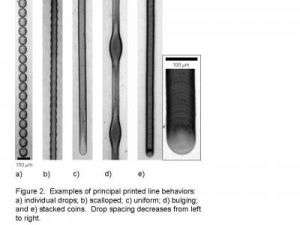Examples of printed line behaviors from inkjet printers: (a) individual drops, (b) scalloped, (c) uniform, (d) bulging, and (e) stacked coins. Credit: Courtesy of the American Chemical Society
Researchers in California report a key advance in efforts to use inkjet printing technology in the manufacture of a new generation of low cost, high-performance electronic circuits for flexible video displays and other products. Their study, which describes development of a new method for producing straighter, uniform circuits using inkjet-printing, is scheduled for the March 4 issue of ACS’ Langmuir.
In the report, Dan Soltman and Vivek Subramanian note that inkjet-printed circuits must be extremely smooth and straight. That difficult feat has been elusive because the drop-by-drop nature of inkjet-printing often leaves uneven printed features on surfaces, especially a circular pattern known as the “coffee ring” effect, they note.
The scientists describe a new way to optimize printing conditions to eliminate the coffee-ring effect and produce smooth, narrow lines with an even edge. The development demonstrates the feasibility of tuning and optimizing inkjet technology for microelectronic applications, they say.
Source: ACS
























